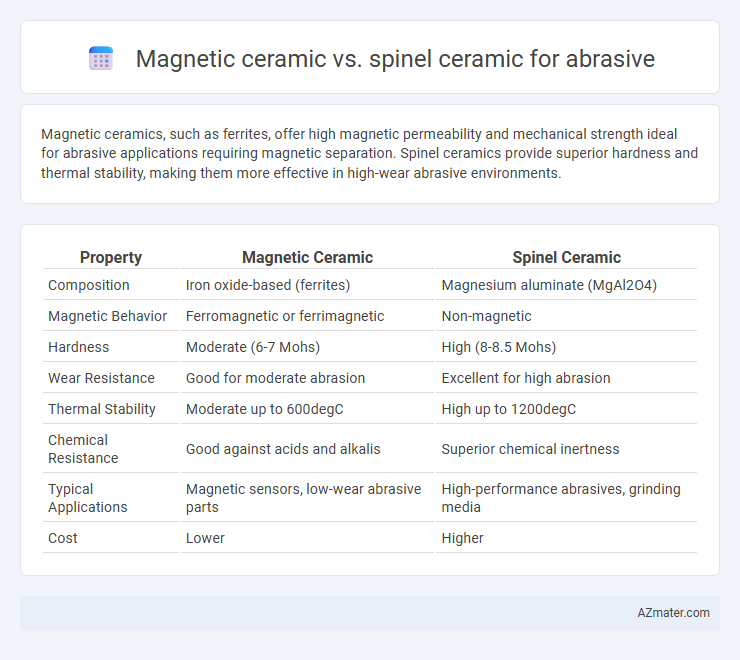Magnetic ceramics, such as ferrites, offer high magnetic permeability and mechanical strength ideal for abrasive applications requiring magnetic separation. Spinel ceramics provide superior hardness and thermal stability, making them more effective in high-wear abrasive environments.
Table of Comparison
| Property | Magnetic Ceramic | Spinel Ceramic |
|---|---|---|
| Composition | Iron oxide-based (ferrites) | Magnesium aluminate (MgAl2O4) |
| Magnetic Behavior | Ferromagnetic or ferrimagnetic | Non-magnetic |
| Hardness | Moderate (6-7 Mohs) | High (8-8.5 Mohs) |
| Wear Resistance | Good for moderate abrasion | Excellent for high abrasion |
| Thermal Stability | Moderate up to 600degC | High up to 1200degC |
| Chemical Resistance | Good against acids and alkalis | Superior chemical inertness |
| Typical Applications | Magnetic sensors, low-wear abrasive parts | High-performance abrasives, grinding media |
| Cost | Lower | Higher |
Introduction to Magnetic Ceramic and Spinel Ceramic
Magnetic ceramics, primarily composed of ferrite compounds like iron oxide mixed with other metal oxides, exhibit strong magnetic properties and high wear resistance, making them ideal for abrasive applications requiring durability and magnetic functionality. Spinel ceramics, characterized by their cubic crystal structure with a formula AB2O4, combine excellent hardness, thermal stability, and chemical resistance, offering superior performance in abrasive environments prone to high temperature and corrosive conditions. Both magnetic and spinel ceramics provide tailored solutions for abrasives, with magnetic ceramics favored for magnetic responsiveness and spinel ceramics excel in toughness and thermal endurance.
Composition and Structure Comparison
Magnetic ceramics typically consist of ferrites with iron oxide combined with other metal oxides like cobalt, manganese, or nickel, resulting in a crystalline structure that exhibits strong magnetic properties. In contrast, spinel ceramics possess a unique cubic crystal structure characterized by the general formula AB2O4, where A and B represent different metal cations such as magnesium, aluminum, or zinc, providing excellent mechanical strength and thermal stability. The compositional differences directly influence their abrasive performance, with magnetic ceramics offering enhanced toughness due to magnetic domain interactions, while spinel ceramics provide superior hardness and wear resistance owing to their densely packed lattice.
Manufacturing Processes of Both Ceramics
Magnetic ceramics, typically composed of ferrites, undergo manufacturing processes involving powder preparation, compaction, and high-temperature sintering to achieve desired magnetic and abrasive properties. Spinel ceramics, characterized by their cubic crystal structure (AB2O4), are produced through solid-state reactions or sol-gel methods, followed by strict control of sintering temperature and atmosphere to optimize hardness and wear resistance for abrasive applications. Both ceramics require precise control of particle size distribution and densification to enhance their performance in abrasive tools and components.
Physical and Chemical Properties
Magnetic ceramics, typically composed of ferrites like barium or strontium ferrite, exhibit high magnetic permeability and electrical resistivity, making them suitable for applications requiring magnetic functionality and abrasion resistance. Spinel ceramics, primarily magnesium aluminate (MgAl2O4), offer superior chemical stability, high hardness, and excellent thermal shock resistance, ideal for abrasive environments exposed to corrosive chemicals and high temperatures. Physical properties such as density and hardness are generally higher in spinel ceramics, while magnetic ceramics provide unique magnetic properties combined with moderate mechanical strength.
Magnetic Properties and Applications
Magnetic ceramics, such as ferrites, exhibit strong magnetic permeability and excellent electrical resistivity, making them ideal for abrasives in electromagnetic shielding and magnetic field applications. Spinel ceramics possess a stable crystal structure with moderate magnetic properties, enabling their use in abrasive processes where wear resistance and thermal stability are critical but magnetic performance is secondary. The choice between magnetic ceramic and spinel ceramic abrasives depends on the application's requirement for magnetic responsiveness versus mechanical durability.
Abrasive Performance Metrics
Magnetic ceramics typically exhibit higher hardness and fracture toughness, providing superior abrasion resistance and longer wear life in abrasive applications. Spinel ceramics, while offering excellent thermal stability and chemical resistance, generally have lower hardness, resulting in moderate abrasion performance compared to magnetic ceramics. Abrasive performance metrics such as wear rate, abrasion resistance index, and impact durability favor magnetic ceramics in high-stress, high-friction environments.
Durability and Wear Resistance
Magnetic ceramics, such as ferrites, offer moderate wear resistance but can suffer from lower durability under high-stress abrasive conditions compared to spinel ceramics. Spinel ceramics, composed primarily of magnesium aluminate, exhibit superior hardness and enhanced durability, making them more resistant to wear and abrasion in industrial applications. The higher crystalline density and fracture toughness of spinel ceramics significantly extend service life in abrasive environments.
Cost-Effectiveness in Abrasive Applications
Magnetic ceramics often present a higher initial cost compared to spinel ceramics but offer improved magnetic properties that enhance abrasive tool performance and lifespan, making them more cost-effective in high-precision applications. Spinel ceramics, with their lower raw material and manufacturing costs, provide excellent wear resistance and toughness, ideal for large-scale abrasive use where budget constraints are crucial. Evaluating the total cost of ownership, including durability and maintenance, spinel ceramics generally outperform magnetic ceramics in cost-effectiveness for abrasive applications requiring moderate performance levels.
Environmental Impact and Sustainability
Magnetic ceramics, typically composed of iron oxides, exhibit higher energy consumption in manufacturing due to sintering at elevated temperatures, but offer recyclability benefits through magnetic separation techniques. Spinel ceramics, with their stable magnesium aluminate structure, are produced using relatively low-temperature processes, reducing carbon footprint and enhancing eco-friendliness. Both materials contribute to sustainability by enabling longer tool life and reduced waste generation in abrasive applications, yet spinel ceramics show a slight environmental advantage in lifecycle emissions and resource efficiency.
Choosing the Right Ceramic: Key Considerations
Magnetic ceramics, primarily composed of ferrite materials, offer superior magnetic properties and wear resistance, making them suitable for applications requiring both abrasion tolerance and electromagnetic functionality. Spinel ceramics, such as magnesium aluminate (MgAl2O4), provide excellent thermal stability, high hardness, and chemical inertness, ideal for abrasive environments with high temperatures or corrosive conditions. Choosing the right ceramic depends on factors like operating temperature, mechanical strength, magnetic requirements, and environmental exposure to optimize abrasion performance and longevity.

Infographic: Magnetic ceramic vs Spinel ceramic for Abrasive
 azmater.com
azmater.com